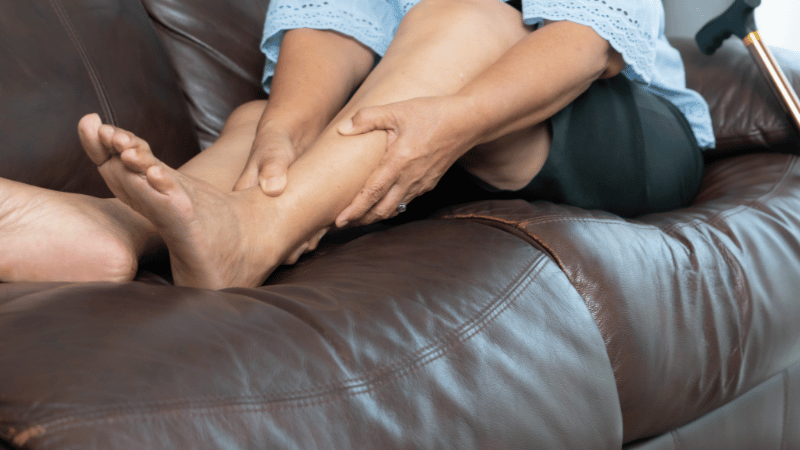When one of your legs feels consistently numb, cold, or tingly, it’s easy to wonder why. These symptoms are often just temporary, but if they persist, they could be a sign of an underlying circulatory issue like peripheral artery disease (PAD). Understanding the cause is the first step to finding relief.
What It Means When Only One Leg Feels Cold and Numb
Sometimes, numbness or discomfort in one leg is completely normal. It’s often due to simple things like:
- Sitting for a long time: Staying in one position can lead to temporary numbness. This usually goes away once you stand up and move around.
- Being in a cold room: A prolonged chill can cause a feeling of coldness, pain, or numbness in one of your legs. Getting to a warmer place should fix this.
However, if the discomfort doesn’t go away after you’ve changed positions or warmed up, it could be a sign of an underlying issue, like a circulation problem. In that case, you should consult a doctor to find the cause.
Common Causes of Coldness and Numbness in One Leg
An underlying circulatory, neurological, or musculoskeletal issue can cause coldness or numbness in one leg. However, peripheral artery disease (PAD) and poor circulation are the most common causes of coldness or numbness in one leg.
Circulatory Causes
If the feeling or sensation of coldness and numbness in one leg is constant, it could indicate restricted blood flow to the extremities. Chronic coldness or numbness in one leg may stem from several vascular issues, including:
- Diabetic neuropathy: Diabetic neuropathy can lead to numbness in the legs, feet, or hands. The numbness is typically paired with digestive issues, sharp pain, or a burning sensation.
- Peripheral artery disease (PAD): PAD restricts blood flow to the legs, ankles, and feet. Lack of blood flow can cause pain, numbness, and weakness in one or both legs. PAD is a serious vascular condition that requires medical intervention to slow the progression. It is one of the most common causes of coldness in one leg.
- Deep vein thrombosis (DVT): This serious condition typically causes pain in one leg, either the calf or thigh. Patients may also experience throbbing, swelling, coldness, or numbness.
Neurological & Musculoskeletal Causes
Neurological and musculoskeletal disorders may also cause one-sided leg symptoms, typically characterized by sharp and sudden pain. Some patients experience sudden pain or gradual pain that gets worse over time.
- Sciatica or spinal nerve compression: Compression of the nerves in the lower back can cause numbness in one leg. Some patients also experience increased pressure near the sciatic nerve.
- Peripheral neuropathy (early stages): Peripheral neuropathy is damage to nerves outside the brain and spinal cord that disrupts sensation and movement. During the early stages of peripheral neuropathy, patients may experience asymmetrical sensory and motor symptoms in the legs and feet.
- Herniated disc or spinal stenosis: A pinched nerve can cause pain, numbness, or a tingling sensation in one limb.
Why Peripheral Artery Disease Is The Common Cause of One Cold & Numb Leg
Peripheral artery disease is a progressive disease that primarily impacts the lower extremities. It’s caused by a buildup of plaque in the arteries. As the plaque builds up, it restricts the flow of blood, oxygen, and nutrients, leading to a cold sensation in the affected leg. The cold sensation is typically accompanied by pain, numbness, and weakness. Depending on the condition, symptoms can appear in one or both legs.
PAD symptoms can vary depending on the affected arteries and the severity of the blockage. When a blockage occurs in one artery, it’s called a unilateral blockage. Unilateral blockages can cause coldness, numbness, and pain to appear in the leg where the affected artery is. PAD symptoms can also progress asymmetrically, causing pain to be more prominent in one leg.
How The Leg Being Cold and Numb May Indicate PAD
The most common causes of coldness and numbness in the legs are poor blood flow and circulation. While there are other vascular conditions with similar symptoms, PAD typically only impacts the lower extremities.
Patients with a cold and numb leg caused by peripheral artery disease (PAD) typically experience tightness, cramping, or discomfort during physical activity. The skin may be cold to the touch, especially below the knee, with symptoms improving or worsening depending on movement and progression.
One of the more common symptoms is called claudication, a painful cramping in the legs caused by decreased blood flow to the muscles. Claudication pain usually eases when resting, but if the aching continues, it can be a sign that PAD has progressed and requires treatment.
If you’re experiencing coldness or numbness in one leg and it’s accompanied by any other symptoms like leg pain, discoloration, or slow-healing wounds, schedule a consultation with a vascular specialist for a vascular screening.
Is One Colder Leg Always a Sign of PAD?
Coldness in one leg is not always a sign of peripheral artery disease (PAD). However, when combined with other symptoms, a vascular evaluation is recommended.
Other symptoms of PAD, in addition to coldness or numbness in one leg, include:
- Achy, tired legs
- Heaviness in one or both of your legs or feet
- Cramping in your buttocks, thighs, calves, or feet
- Discoloration
- Leg(s) turning a pale blue or gray color
- Shiny skin
- Difficulty walking or climbing stairs
- Wounds that don’t heal
- Numbness in one leg while walking
- Hair loss or slow growth
In some cases, individuals with PAD may be asymptomatic and not experience any symptoms. This is what makes it necessary to understand the risk for PAD and when to get a proper diagnosis from a vascular specialist.
Take The PAD Risk Assessment Quiz
When to See a Doctor for One Leg Being Cold or Numb
PAD is a progressive disease, meaning the blockages in the arteries will likely get worse over time. Delaying treatment may exacerbate symptoms and lead to serious complications. Waiting until PAD becomes severe may also limit treatment options. Speaking with a professional who can recommend early intervention and lifestyle changes can help manage disease and symptom progression.
Diagnosing the Cause of Feeling Cold and Numb in One Leg
If you have any symptoms of PAD, consult with a vascular specialist for an evaluation and a diagnosis. At USA Vascular Centers, we use three different types of tests to diagnose PAD:
- Ankle-Brachial Index: Used to measure and compare blood pressure near your ankles and feet.
- Angiogram: Uses iodine dye to provide images of your arteries and detect the location of a blockage.
- Blood Tests: To detect high cholesterol or other contributing factors of PAD.
For patients diagnosed with PAD, a vascular specialist will walk through treatment options and create a custom treatment plan based on the severity of the condition.
PAD Treatment Options for Circulatory Issues
USA Vascular Centers offers minimally invasive, non-surgical PAD procedures designed to restore blood flow and alleviate symptoms such as coldness, numbness, and tingling in the legs.
- Angioplasty: A small balloon is inserted into the affected artery via a catheter. The balloon then expands, pushing the plaque against the artery walls and restoring blood flow.
- Stenting: Following angioplasty, a stent, a hollow tube that remains in place, is inserted, keeping the artery open at the site of the blockage.
- Atherectomy: This treatment removes accumulated plaque with a laser or tiny blade, allowing blood to flow through the artery freely.
Determining the best treatment depends on the severity of PAD and patient-specific requirements. A vascular specialist can recommend medications, lifestyle changes, and non-surgical treatments to slow the progression of PAD.
Relieve Coldness and Numbness in One Leg with USA Vascular Centers
Coldness or numbness in one leg is not always harmless, especially if the sensation is persistent. If experiencing symptoms in one leg, schedule a consultation with a vascular specialist to determine if the cause is PAD-related.
USA Vascular Centers offers expert diagnosis and outpatient treatments for patients with PAD. Our specialists will develop a personalized treatment plan that helps restore blood flow and provide long-term relief.
Call Now to Book an Appointment
FAQs About Cold and Numbness in One Leg
Can PAD cause numbness without pain in one leg?
PAD can cause numbness in one leg without pain, due to restricted blood flow, though pain or weakness may also develop over time.
Why would coldness and numbness only affect one leg and not both?
Coldness and numbness in one leg can occur when a condition like peripheral artery disease (PAD), deep vein thrombosis (DVT), or nerve damage, such as diabetic neuropathy, affects one side more than the other.
Is it possible for cold, numb sensations in one leg to occur intermittently?
It’s possible for cold or numb sensations in one leg to come and go, especially if caused by prolonged sitting, poor circulation, or nerve compression.




